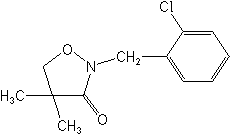| Common
Name: |
Clomazone
|
| Chemical
Name: |
2-(2-chlorobenzyl)-4,4-dimethyl-1,2-oxazolidin-3-one
|
| CAS
No.: |
81777-89-1
|
|
Structure: |

|
| Molecular
Formula: |
C12H14ClNO2
|
| Molecular
Weight: |
239.7
|
| Physical
Chemistry: |
The technical grade is a slight yellow viscous liquid, relative density 1.19, vapour pressure 1.92mPa ( 25℃),Solubility in water 1.1g/l at 20℃, Miscible with ace fone, easily soluble in acetone, acetonitrile, chloroform, cyclohexanone, methanol, methylbenzene etc, organic solvents. Stable in alkaline and acid media (pH4.5~9.25) material,corrosive to metal, and no losing when stouage for one year at room temperature.
|
| Toxicity: |
Technical grade is low toxic herbicide. Acute oral for male rat LD60>2000mg/kg,for female LD50 1369 mg/kg, acute dermal for rat LD50>2000mg/kg. Non-irritarive to eye and skin. In the studies, there is no finding Carcinogenicity, Mutagenicity and Teratogenicity effects.Blue sunfish LC50(96 hours)34mg/l, rainbow trout LC50(96 hours)19mg/l. bird LC50>5000mg/kg(maliard).
|
| Application: |
Clomazone is a broad spectrum herbicide used for control of annual grasses and broadleaf weeds in cotton, peas, pumpkins, soybeans, sweet potatoes, tobacco, winter squash and fallow wheat fields. It can be applied early preplant, preemergent or preplant-incorporated depending on the crop, geographical area and timing. Because clomazone is an inhibitor of plant pigments, users must exercise caution to avoid drift or vapors which may cause bleaching damage to non-target foliage.
|
| Technical
Purity: |
95%Tech
|
| Formulation
Type: |
48%EC
| |



